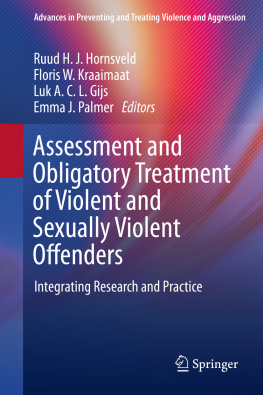First published by Willan Publishing 2005
This edition published by Routledge 2011
2 Park Square, Milton Park, Abingdon, Oxon OX14 4RN
711 Third Avenue, New York, NY 10017
Routledge is an imprint of the Taylor & Francis Group
Sarah Brown 2005
The rights of Sarah Brown to be identified as the author of this book have been asserted by her in accordance with the Copyright, Designs and Patents Act of 1988.
All rights reserved; no part of this publication may be reproduced, stored in a retrieval system, or transmitted in any form or by any means, electronic, mechanical, photocopying, recording or otherwise without the prior written permission of the Publishers or a licence permitting copying in the UK issued by the Copyright Licensing Agency Ltd, 90 Tottenham Court Road, London W1P 9HE.
ISBN 978-1-84392-122-6 (paperback)
ISBN 978-1-84392-123-3 (hardback)
British Library Cataloguing-in-Publication Data
A catalogue record for this book is available from the British Library
Project managed by Deer Park Productions, Tavistock, Devon
Typeset by TW Typesetting, Plymouth, Devon
In memory of Sam and Eileen Holwill
A book such as this, which is based almost entirely on the literature, clearly owes a great deal to the efforts of all those who have published their work. Thus, I am indebted to all the authors whose work is included in this book. In addition, I would like to thank all the family, friends and colleagues who have provided support and encouragement throughout the completion of this work. Particular thanks are due to Dr Clare Wood for her enthusiastic reading of draft chapters and subsequent helpful comments and to Steve for his continued love and support.
Chapter 1
Introduction
Over the last two decades, the problem of sexual offending has received widespread public, media and political attention. In fact, Sampson (1994: xi) argued that public concern about sexual crime has become panic. Media reporting has created the image that there has been a dramatic increase in sexual crime and that women and children face a constant and continued threat of attack. Sexual offenders are despised perhaps more than any other type of offender; so much so, that:
The equation of sexual offender and monster is now firmly part of the public psyche. Monster and beast are common euphemisms for sex offenders in the prison system.
(Sampson 1994: 43)
This has been supported by politicians who were keen to play the law and order card, and calls for tougher sentences for sex offenders have largely gone unopposed (Sampson 1994). The result has been a more punitive criminal justice response, enforced by a recent flurry of rushed legislative changes; for example, in England and Wales at least ten statutes affecting sex offenders have been introduced since 1991. Such an approach is not isolated to England and Wales, for example:
Sexual abuse in North America is epidemic and the criminal justice system response to it is, for the most part, more reflexive, fear-driven, and irrational than it is practical.
(Freeman-Longo and Blanchard 1998, cited in Laws 2000b: 30)
During the 1980s, sexual offending emerged as a major social problem, although it was not a new phenomenon (see Calder (1999) for a brief (Home Office 1991; 1995; 2001a; 2004). From 1986 to 1996, the increase in recorded sexual offences averaged around 10 per cent per year (Home Office 2004). In 20034, the half a million recorded sexual offences comprised 26,709 indecent assaults on a female, 1,942 incidents of gross indecency with a child, 13,247 rapes (93 per cent of which were rapes of a female), and 4,070 indecent assaults on a male. Recorded sexual offences in 20034 increased by 7 per cent from the previous year to account for 5 per cent of all recorded violent crimes and 0.9 per cent of all recorded crime (Home Office 2004). A combination of the growth in recorded sexual offences and an increase in media attention to these crimes has led to the impression that sexual offences are becoming more common. However, some of the increase in recorded offences is likely to be attributable to an increasing number of offences being reported to and recorded by the police, rather than an increase in the actual number of offences (Home Office 1995).
The extent of the problem
A wide range of behaviours are officially classified as sexual offences but treatment work (and hence this book) generally focuses on those who offend against either those who did not, or those who could not, give their consent (e.g. offences of child sexual abuse, rape and exhibitionism). It is important to note that sex offending is a legal definition; strictly speaking a sex offender is someone who has been sanctioned by law for a sexual offence, although more widely the term is used (and will be employed in tyhis book) to define those who engage in sexual behaviours that are illegal, whether or not they have been officially sanctioned for these offences. Paedophile on the other hand, a term that is often used interchangeably with sex offender (and child molester), is a clinical definition of a specific group of people who may engage in adultchild sexual behaviour. The fourth edition of the Diagnostic and Statistical Manual of Mental Disorders (DSM-IV) (American Psychiatric Association 1994) classifies paedophilia within a broader category of paraphilias (sexual disorders in which there are strong, recurring sexually stimulating urges, fantasies or behaviours usually involving (a) objects other than humans; (b) humiliation or pain for the partner or self; (c) children or other non-consenting partners). Specifically paedophilia is diagnosed if: (a) for six months or more, a person has had such fantasies or behaviours involving children below the age of puberty; (b) these fantasies/behaviours result in clinically meaningful difficulties or distress at work, in social contexts, or in other major areas of functioning; (c) the person is 16 years or older, and is at least five years older than the child or children. There are many problems with this definition (and the DSM-IV classifications of paraphilias in general, for example, see McConaghy (1999b)) and in using it to clinically diagnose paedophiles. Perhaps most important is the need for clinically meaningful difficulties or distress, which may not be exhibited in many of those who have fantasies, and/or engage in sexual behaviour with children and the need for these fantasies (which clearly cannot be observed) to be reported to the clinician. Crucially in terms of this discussion, it can be seen that not all sex offences (even all those committed against children) are likely to be committed by clinically diagnosed paedophiles (or even those without such formal diagnosis, but who would meet these criteria), even though many refer to all those who sexually offend against children as paedophiles. Although many argue that all clinically diagnosed paedophiles are sex offenders, this does not necessarily follow, as it is possible that someone could experience fantasies and urges that they do not act upon. In this book, to avoid confusion, the term paedophile will only be used if it was used to classify offenders by the authors of the original publication being cited.






